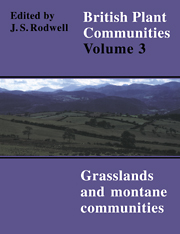Book contents
- Frontmatter
- Contents
- List of Figures
- Preface and Acknowledgements
- Preamble
- Mesotrophic Grasslands
- Community Descriptions
- Calcicolous Grasslands
- Community Descriptions
- Calcifugous Grasslands and Montane Communities
- Community Descriptions
- Index of Synonyms to Grasslands and Montane Communities
- Index of Species in Grasslands and Montane Communities
- Bibliography
MG7 - Lolium Perenne Leys and Related Grasslands Lolio-Plantaginion Sissingh 1969 P.P.
Published online by Cambridge University Press: 04 July 2020
- Frontmatter
- Contents
- List of Figures
- Preface and Acknowledgements
- Preamble
- Mesotrophic Grasslands
- Community Descriptions
- Calcicolous Grasslands
- Community Descriptions
- Calcifugous Grasslands and Montane Communities
- Community Descriptions
- Index of Synonyms to Grasslands and Montane Communities
- Index of Species in Grasslands and Montane Communities
- Bibliography
Summary
The widespread use of cultivars of Lolium perenne and other grasses and the development of a range of distinctive styles of intensive grassland treatment have produced a wide variety of specialised grass-dominated and species-poor swards throughout lowland Britain. Some of these are highly productive short-term agricultural grasslands used for grazing or mowing in rotation with arable farming; others are permanent amenity and recreational swards developed for their resistance to heavy use. Many stands of these grasslands have been specially sown on prepared soils but others have arisen by seeding in to meadows and pastures. Where they pass into permanent agricultural use, they generally come to resemble the Lolio-Cynosuretum', if subject to very heavy trampling, they frequently degenerate to the more open, weedy communities of the same Alliance, the Lolio-Plantiginion.
Loliumperenne-Trifolium repens leys
L. perenne is the only constant in the very species-poor swards included here and it is generally dominant, although where the vigorous L. multiflorum or L. x hybridum ( = L. perenne x multiflorum) or cultivars of Phleum pratense ssp. pratense have been included in the seed mixtures, these may attain local prominence. Trifolium repens is frequent and sometimes abundant and there is often a little Dactylis glomerata. Taraxacum officinale agg., Ranunculus repens and Trifoliumpratense occur occasionally at low cover. On patches of bare soil, annual weeds such as Poa annua, Capsella bursa-pastoris, Stellaria media and Chamomilla suaveolens may gain a hold. Bryophytes are generally absent.
Grasslands of this type are generally sown as part of an arable/ley rotation and are especially valuable for hay or silage with their predominance of tall grasses and for grazing with their rapid growth of aftermath. Provided heavy applications of artificial fertilisers are maintained, the vegetation is highly productive, although, in older swards, coarser grasses such as D. glomerata and Holcus lanatus tend to expand and Cynosurus cristatus may invade. Perennial weeds such as Sonchus arvensis and Cirsium arvense may become tenacious in neglected stands but judicious treatment can convert the vegetation into productive Lolio-Cynosuretum.
Lolium perenne-Poa trivialis leys
The grasslands of this type are somewhat more speciesrich than the Lolium-Trifolium leys. L. perenne and P. trivialis are usually co-dominant but D. glomerata, P. pratense ssp. pratense and T. repens are also constant and may be abundant. In older stands, Festuca rubra, Agrostis capillaris and H. lanatus become more frequent.
- Type
- Chapter
- Information
- British Plant Communities , pp. 74 - 78Publisher: Cambridge University PressPrint publication year: 1992



